July 7, 2012. Marine forecast: SW 10-15 knots, with 15 knots later.
I arrived down at the landing at 1PM, and was disappointed to find that the sea breeze had not filled in yet. The heat and humidity approached oppressive. South down the ICW, a neighbor’s flag was limp. Further to the south, beyond Garris Landing, the surface of the water appeared darker. The flag soon came to life, flapping to attention, and broadcasting the southwest flow. That was all I needed to galvanize into action – rigging Kingfisher, launching her, and tying up at the dock. As I pulled the trailer out and parked my truck, my neighbor Sam Welsh arrived with his paddleboard. He was not thrilled at the arrival of the wind, a reaction opposed to my relief. I needed more than just a little wind since I had planned more than a little sail: it would be a rounding, a circumnavigation of Bull Island. I would sail south in the ICW to Price’s Creek and Price’s Inlet, pass over the inlet shoals, and sail north up the island past the Boneyard to the Northeast Point, and then across Bulls Bay to Andersonville Creek and home. Though having completed this sail a few times, it was far from routine.
The last time I made this sail around the island was two years ago – Around Again. The first leg of the journey’s challenge was beating up the ICW, and dodging traffic. Sailboats do have the right-of-way, but I typically give the channel to powerboats. The tide still had three hours to fall, so we had plenty of water to maneuver. The air was hot but made bearable by the sea breeze. It was about an hour to the entrance to Price’s Creek – the passage through the marsh. I took the opportunity here to take a plunge into the creek to cool down. After several bends in the creek I had a clear view into the inlet, and the flotilla of craft was bigger than anticipated. On the north side of the creek before Bull Island were several rafts of boats, some quite large, moored to the outgoing tide. Kingfisher and I passed Little Bulls Island at 3PM, and were soon heading out the inlet between Bull Island to port and Capers Island to starboard. It was a veritable gauntlet of outboards anchored on both sides. Close hauled on the starboard tack, it was as if we were in a tunnel passing dozens of boats, with the sounds of voices wafting toward me from windward. Kingfisher kept up a steady sound of chugging through the waters, pulled by both the SW wind and the outgoing tide. We were soon past the masses (40-50 boats), with just a couple left ahead on the shoal stretching out from Capers Island. 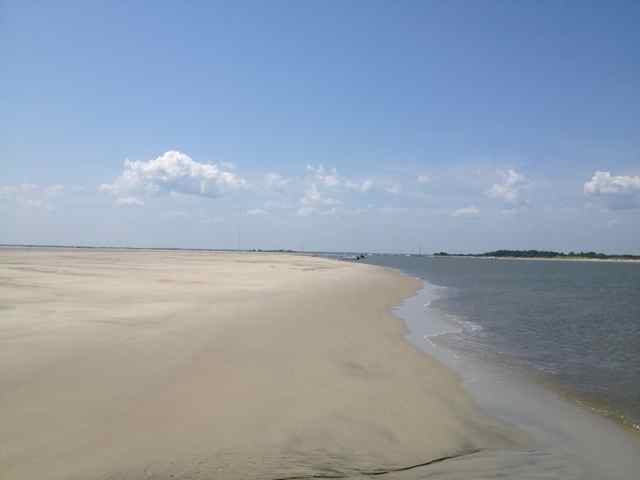
I made a brief stop on this bar, hydrating, surveying the scene and taking a few photos. The sights and sounds of the flotilla were at this time downwind. Ahead was the outer portions of Price’s Inlet, and the shoal on the Bull Island side was my barrier to turning this corner and heading down the island via the ocean. 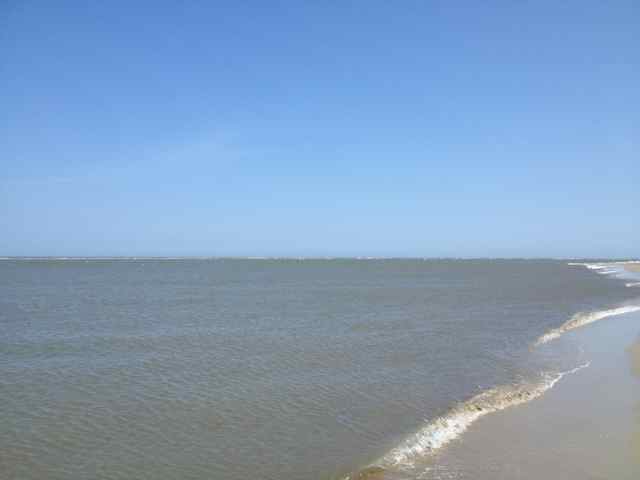 This shoal stretches out from the island’s southern end a long way into the ocean, and my challenge was to find a passage where we would have enough water to cross this shoal and not run aground (in the waves), and to not have to go all the way out to the bitter end of the shoal, quite a distance to windward.
This shoal stretches out from the island’s southern end a long way into the ocean, and my challenge was to find a passage where we would have enough water to cross this shoal and not run aground (in the waves), and to not have to go all the way out to the bitter end of the shoal, quite a distance to windward.
So we were off and headed outward bound, and I picked a course through what I felt was the best place to cross the shoal. I miscalculated the swell: they were bigger than anticipated, and breaking. This would not be a good place to capsize; I continued the crossing and worked through the white water. I maintained the rules I have learned in sailing against breaking waves: keep the boat moving, and not get caught broadside to a wave – I had capsized in that position on the north side of Bulls Bay once with a small wave. I made it through several waves, and had some open space when I saw the next wave approaching, and becoming critical. I hoped to make it over the top, but it began to break, leaving me with the only good alternative to shoot the bow directly into the wave and power through. The worst scenario here would be to be capsized backward, throwing me off and potentially breaking spars, even the mast step. But we were through, and past the breaking waves.
Free, yet Kingfisher’s cockpit was half full of water, and she wallowed along in the swells. I put my sponge to work, removing the Atlantic’s waters that were floating sandals and cooler. It took a while, but after ten minutes of sponging I was able to get the cockpit dry. I recalled solo sailer Neal Peterson’s story of bailing. His sailing vessel Protect Our Sealife was hit in heavy fog by a Russian freighter during his second transatlantic solo race, and he had to pump by hand the rest of the days – 20 minutes out of every hour. It put my little need for bailing in perspective. My course was northeast as we sailed on a broad reach. MIles ahead the Boneyard was the next turning point. We were far off the beach, and all alone, with the crowds of Price’s Inlet far behind, and the view to that direction all sun and brilliant reflection. I had to take care on this broad reach to not bury the bow when surfing swells.
Continuing the sail to the northeast, we slowly converged with the coast, and heard a new sound – the low roar of the surf. The sail from the shoals to the Boneyard was 35 minutes of riding swells on a sparkling ocean. We stayed in close for a short turn to the NNE, but not so close as to sail through the partially submerged trees. We were soon by the open area accessible by vehicles above the beach. The swells here permitted some of the best surfing as yet, charging down the face of waves on our last leg of the sail to the Northeast Point. A couple appeared walking on the beach, and then a second – the only people seen on the island since Price’s Inlet. There were more shoals ahead before the Point, and after running out a bit we jibed back on the port tack and approached these breaking waves. It was an exhilarating ride of using the waves to our advantage, and feeling the thrill of surfing, though taking care to keep the bow from submarining. Past the shoals, smooth water marked the final passage to the Point, and I kept Kingfisher off to avoid a submerged tree somewhere in this vicinity. Having made this inlet in less than an hour after crossing the shoals at Price’s, we rounded up to a close reach.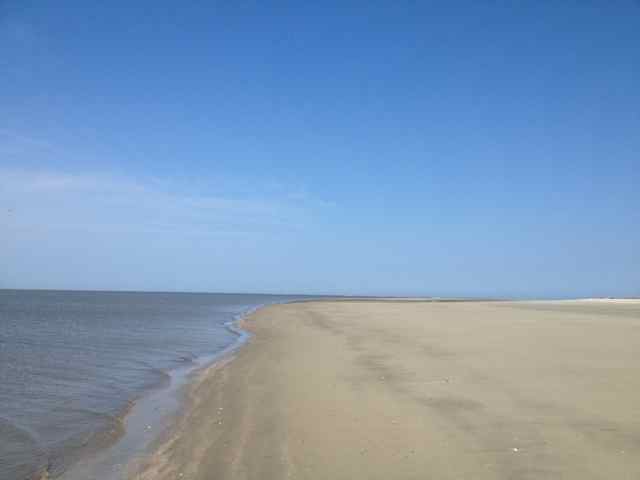
We landed at the Point for a brief break, and surveyed the scene. This inlet was far different than Price’s: only four boats in sight, one anchored and fishing the last of the outgoing tide in the channel. 
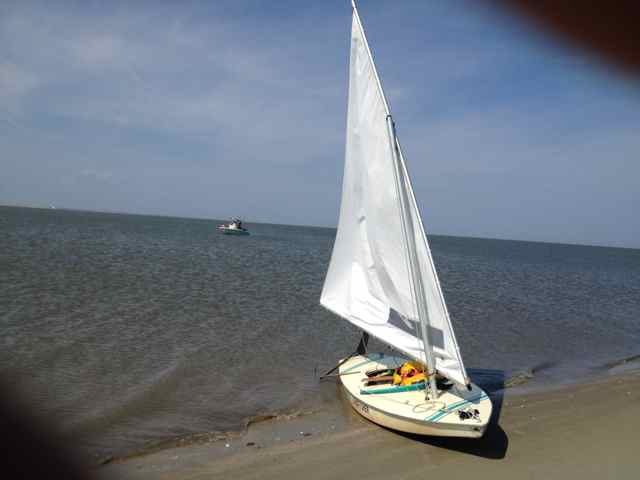 The last leg was a close reach across the southwestern end of Bulls Bay heading west, and the marine forecast had correctly predicted the winds to be stronger. That breeze was completely solid, evidencing no variation in strength or direction. For efficiency Kingfisher needed to be sailed flat, hiking to keep the hull flat and the sail hauled in tight. Ahead the lowering sun produced a shimmering sky and water’s surface, and this shimmering came in sheets of glare and occasional spray from the hull ripping through the water. There was still an hour left of ebbing tide that I bucked, but it provided no impediment to our fast passage to the creek’s mouth. There were no other boats seen – we were solo as in the ocean.
The last leg was a close reach across the southwestern end of Bulls Bay heading west, and the marine forecast had correctly predicted the winds to be stronger. That breeze was completely solid, evidencing no variation in strength or direction. For efficiency Kingfisher needed to be sailed flat, hiking to keep the hull flat and the sail hauled in tight. Ahead the lowering sun produced a shimmering sky and water’s surface, and this shimmering came in sheets of glare and occasional spray from the hull ripping through the water. There was still an hour left of ebbing tide that I bucked, but it provided no impediment to our fast passage to the creek’s mouth. There were no other boats seen – we were solo as in the ocean.
This shimmering solitary zone was finally dissipated after we returned to the creek and marsh, and several boats appeared. Coming into the ICW at almost low tide, the shoal to starboard was covered with birds, and I bore off parallel to the flat to observe the black skimmers and various terns. Too close, and the daggerboard crunched the shell covered bottom. Up board and down helm, and Kingfisher was free again, headed toward the landing. Then it was up into the wind for a sail drop, and paddle into the shallow basin. As anticipated, there was not enough water to haul out easily. I secured Kingfisher to the dock, and would wait to bring her home after dinner.
Upon returning later the sun was much lower, and the colors were rosy and softer. 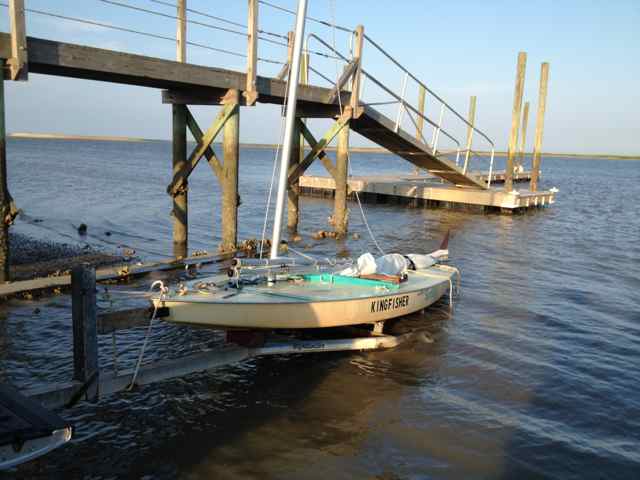 It was relatively easy to pull her out, but I could feel muscle fatigue from the four-hour sail. I pondered two questions again that had popped up in the final creek passage: how long would I be able to make sails such as this one? And when and how would I know that I had to pull the plug – only entertain more moderate trips? These were not questions I cared to dwell on, for at the moment this was a sail I could still make. And I would.
It was relatively easy to pull her out, but I could feel muscle fatigue from the four-hour sail. I pondered two questions again that had popped up in the final creek passage: how long would I be able to make sails such as this one? And when and how would I know that I had to pull the plug – only entertain more moderate trips? These were not questions I cared to dwell on, for at the moment this was a sail I could still make. And I would.
Hi Bob,
Another wonderful trip! Did you get a new Kingfisher? Maybe I missed it but that one looks newer?
Ron
New mast, but old Kingfisher, though much has been replaced (mast x2, rudder x2, and sail). And still same old skipper.
Pith. More pith. And pithily I further remark pithier pith.
And then I sailed past the pith.
It was a good jib.
A pithy jib.
I like the cut of this jib.
A pithy cut.
You have seen Kingfisher’s jib, have you?
🙂